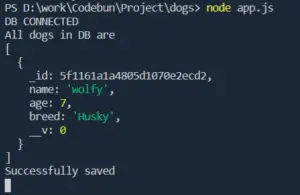How to setup up Schema for MongoDB using mongoose. In this tutorial, we are going to learn about the schema, how to set up a schema in the MERN application, and how the database can handle them.
To understand Schema we will create a small database for dogs and will also make a dog schema that would take the name, age, and breed of the dog.
What is Schema?
The database schema of a database is its structure described in a simple language supported by the database management system. The term “Schema” refers to the organization of data as a blueprint of how the database is constructed. The formal definition of a database schema is a set of formulas called integrity constraints imposed on a database.
⇒ MongoDB saved the information/data in the form of javaScript Object Notation(json) document.As it a non relational database.
⇒ Data is saved in a pattern format and this pattern is set by creating a model of the format of data.
⇒ These models are a very important part of MVC workflow. They are created using the schema function of mongoose.
⇒ This is like a bridge between the database and the web app.
This Small project of dogs will explain how to create schemas and use them.
Steps:-
- Create a folder and initialize the project using npm init.
- Create an app.js file and install mongoose using the below command.
PS D:\work\Codebun\Project\dogs>npm i mongoose
- Require the mongoose in app.js
- Connect to the database using mongoose.connect
- Use the Mongoose.Schema() function to specify the model and then use it to save data.
- Create an object of that model filling the information and use the mongoose function to save the data to the database.
- Use the mongoose.find() function.
Setup up Schema for MongoDB using mongoose
const mongoose = require("mongoose");
//connecting to database
mongoose.connect("mongodb://localhost:27017/Dogs",{
useNewUrlParser:true,
useUnifiedTopology:true,
useCreateIndex:true
})
.then(() => {
console.log("DB CONNECTED");
});
//Schema
var dogSchema = new mongoose.Schema({
name: String,
age: Number,
breed:String
})
var Dog = mongoose.model("Dog",dogSchema);
//Create
Dog.create({
name: "wolfy",
age: 7,
breed: "Husky"
}, function(err, dog){
if(err){
console.log(err);
} else {
console.log("Successfully saved"
);
}
});
//Show Collections
Dog.find({},(err, dog)=>{
if(err){
console.log("Not Worked");
console.log(err);
}else{
console.log("All dogs in DB are");
console.log(dog);
}
})
⇒ Run the code using the command node app.js
PS D:\work\Codebun\Project\dogs>node app.js
OUTPUT
Note op is in command prompt/terminal

Note: The _id is created automatically and is unique for each object.